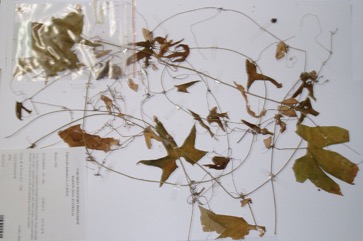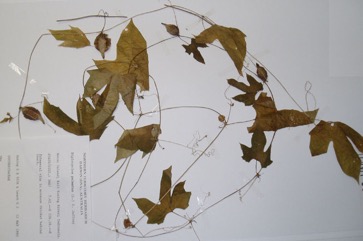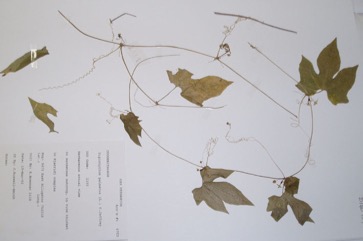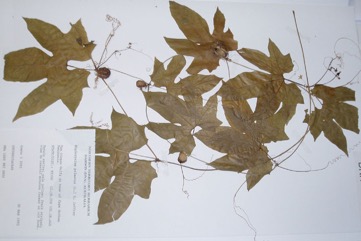Striped cucumber, Native Bryony

It is a tropical plant. It occurs on the coast in Papua New Guinea and grows up to about 1000 m above sea level. It Africa it grows to 1,830 m above sea level. It needs a well drained soil and can grow in a sunny or partial shady position. The plant also grows in Africa, India, Malaysia, China and Australia. There are a couple of subspecies. It can grow in arid places.
Also known as:
Aattupudal, Ba-da, Ban kakra, Bankarela, Kavdoli, Kongakonga, Korek kotok, Kuniyanchappu, Lollipop climber, Luongluan chan-vit, Mahadevpind, Malaipusanni, Shanker-vel, Shivlingi, Sivalingakkai, Sivalingi, Uvakandasopu
Synonyms
- Bryonia affinis Endl.
- Bryonopsis affinis (Endl.) Cogn.
- Bryonia lacinosa L.
- Bryanopsis lacinosa (L.) Naud.
- Bryonia palmata L.
- Bryonopsis pancheri (Naudin) Naudin
- Ilocania pedata Merr.
- Trichosanthes muelleri Cogn.
- Zehneria erythrocarpa F. Mueller
Edible Portion
- Leaves, Fruit, Caution, Vegetable
Where does Striped cucumber grow?
Found in: Africa, Asia, Australia, Bhutan, Cambodia, Central Africa, China, Congo, East Africa, East Timor, Egypt, Himalayas, India, Indochina, Indonesia, Japan, Kenya, Laos, Madagascar, Malaysia, Mozambique, Myanmar, Nepal, New Caledonia, Norfolk Island, North Africa, Pacific, Pakistan, Papua New Guinea, PNG, Philippines, Rwanda, Sao Tome and Principe, SE Asia, Solomon Islands, Southern Africa, Sri Lanka, Sudan, Taiwan, Tanzania, Thailand, Timor-Leste, Uganda, United States, Vanuatu, Vietnam, Zimbabwe
Notes: The seeds are used as medicine in Nepal. There are 3-5 Diplocyclos species.
Status: A reasonably common wild creeper in coastal areas of Papua New Guinea and many tropical countries. Leaves are used in the Gazelle Peninsula. Because of its poisonous components, its use as a food should probably not be encouraged.
Growing Striped cucumber, Native Bryony
Cultivation: Plants can be grown from seeds or cuttings.
Edible Uses: The leaves are eaten, cooked. CAUTION The fruit are claimed to be poisonous. It is considered to be poisonous in Australia, but is eaten in India and Nepal. It probably needs to be well cooked. The young fruits are occasionally cooked and eaten.
Nutrition Info
per 100g edible portion| Edible Part | Energy (kcal) | Protein (g) | Iron (mg) | Vitamin A (ug) | Vitamin c (mg) | Zinc (mg) | % Water |
|---|---|---|---|---|---|---|---|
| - | - | - | - | - | - |
Striped cucumber, Native Bryony Photos




References
Acharya K. P. and Acharya, R., 2010, Eating from the Wild: Indigenous knowledge on wild edible plants in Parroha VDC of Rupandehi District, Central Nepal. International Journal of Social Forestry. 3(1):28-48
Arinathan, V., et al, 2007, Wild edibles used by Palliyars of the western Ghats, Tamil Nadu. Indian Journal of Traditional Knowledge. 6(1) pp 163-168
Arora, R. K., 2014, Diversity in Underutilized Plant Species - An Asia-Pacific Perspective. Bioversity International. p 48
Bodkin, F., 1991, Encyclopedia Botanica. Cornstalk publishing, p 347
Chandrakumar, P., et al, 2015, Ethnobotanical studies of wild edible plants of Gond, Halba and Kawar tribes of Salekasa Taluka, Gondia District, Maharashtra State, India. International Research Journal of Pharmacy 6(8)
Cooper, W. and Cooper, W., 2004, Fruits of the Australian Tropical Rainforest. Nokomis Editions, Victoria, Australia. p 140
Cowie, I, 2006, A Survey of Flora and vegetation of the proposed Jaco-Tutuala-Lore National Park. Timor-Lests (East Timor) www.territorystories.nt/gov.au p 46
Elliot, W.R., & Jones, D.L., 1984, Encyclopedia of Australian Plants suitable for cultivation. Vol 3. Lothian. p 289
Flora of Australia, Volume 8, Lecythidales to Batales, Australian Government Publishing Service, Canberra (1982) p 178
Flora of Australia Volume 49, Oceanic Islands 1, Australian Government Publishing Service, Canberra. (1994) p 129
Flora of Pakistan. www.eFloras.org
French, B.R., 1986, Food Plants of Papua New Guinea, A Compendium. Asia Pacific Science Foundation p 85
French, B.R., 2010, Food Plants of Solomon Islands. A Compendium. Food Plants International Inc. p 322
Grubben, G. J. H. and Denton, O. A. (eds), 2004, Plant Resources of Tropical Africa 2. Vegetables. PROTA, Wageningen, Netherlands. p 289
Jackes, B.R., 2001, Plants of the Tropics. Rainforest to Heath. An Identification Guide. James Cook University. p 48
Jadhav, R., et al, 2015, Forest Foods of Northern Western Ghats: Mode of Consumption, Nutrition and Availability. Asian Agri-History Vol. 19, No. 4: 293-317
Jones, D.L. & Gray, B., 1977, Australian Climbing Plants. Reed. p 98
Kachenchart, B., et al, 2008, Phenology of Edible Plants at Sakaerat Forest. In Proceedings of the FORTROP II: Tropical Forestry Change in a Changing World. Bangkok, Thailand.
Kew Bull. 15:352. 1962
Kuvar, S. D. & Shinde, R. D., 2019, Wild Edible Plants used by Kokni Tribe of Nasik District, Maharashtra. Journal of Global Biosciences. Volume 8, Number 2, 2019, pp. 5936-5945
Lazarides, M. & Hince, B., 1993, Handbook of Economic Plants of Australia, CSIRO. p 82
Manandhar, N.P., 2002, Plants and People of Nepal. Timber Press. Portland, Oregon. p 204
Melzer, R. & Plumb, J., 2011, Plants of Capricornia. Belgamba, Rockhampton. p 362
Morley, B.D., & Toelken, H.R., (Eds), 1983, Flowering Plants in Australia. Rigby. p 99
Mukhia, P.K., et al, 2013, Wild plants as Non Wood Forest Products used by the rural community of Dagana, a southern foothill district of Bhutan, SAARC Journal, 27 pages
Narayanan Ratheesh, M. K. et al, 2011, Wild edible plants used by the Kattunaikka, Paniya and Kuruma tribes of Wayanad District, Kerala, India. Journal of Medicinal Plants Research Vol. 5(15), pp. 3520-3529
Nicholson, N & H., 1996, Australian Rainforest Plants 3, Terania Rainforest Publishing. NSW. p 22
Njoroge, G. & Newton, L. E. 1994, Edible and Poisonous Species of Cucurbitaceaea in the Central Highlands of Kenya. Journal of East African Natural History. 83:101-115
Paczkowska, G. & Chapman, A.R., 2000, The Western Australian Flora. A Descriptive Catalogue. Western Australian Herbarium. p 221
Peekel, P.G., 1984, (Translation E.E.Henty), Flora of the Bismarck Archipelago for Naturalists, Division of Botany, Lae, PNG. p 547, 546
Pham-Hoang Ho, 1999, An Illustrated Flora of Vietnam. Nha Xuat Ban Tre. p 576
Rajasab, A. H. et al, 2004, Documentation of folk knowledge on edible wild plants of North Karnataka. Indian Journal of Traditional Knowledge. Vol 3(4) pp 419-429
Royal Botanic Gardens, Kew (1999). Survey of Economic Plants for Arid and Semi-Arid Lands (SEPASAL) database. Published on the Internet; http://www.rbgkew.org.uk/ceb/sepasal/internet [Accessed 16th April 2011]
Sarvalingam, A., et al, 2014, Wild edible plant resources used by the Irulas of the Maruthamalai Hills, Southern Western Ghats, Coimbatore, Tamil Nadu. Indian Journal of Natural Products and Resources 5(2):198-201
Townsend, K., 1994, Across the Top. Gardening with Australian Plants in the tropics. Society for Growing Australian Plants, Townsville Branch Inc. p 162
Wheeler, J.R.(ed.), 1992, Flora of the Kimberley Region. CALM, Western Australian Herbarium, p 249
Wild edible plants of Himachal Pradesh
World Checklist of Useful Plant Species 2020. Royal Botanic Gardens, Kew
Yang, Si-Lin and Walters, T. W., 1992, Ethnobotany and the Economic role of the Cucurbitaceae of China. Economic Botany, Vol. 46, No. 4, pp. 349-367